Easter Traditions
Easter is in its essence a religious holiday celebrating the resurrection of Jesus Christ. It is also a celebration of life in general. For many it includes Easter eggs, cute bunnies and lot of chocolate. The following lines will tell you something about unique traditions of Easter celebration in different parts of our planet.
Let's start our little journey in the north of Europe. In the Norwegian capital of Oslo there is procession known as Korsvandring (Cross wandering). The procession of people following the person who carries a huge cross starts in the Oslo cathedral. It ends in the St. Olav Catholic Church. People use red flowers to decorate the cross.
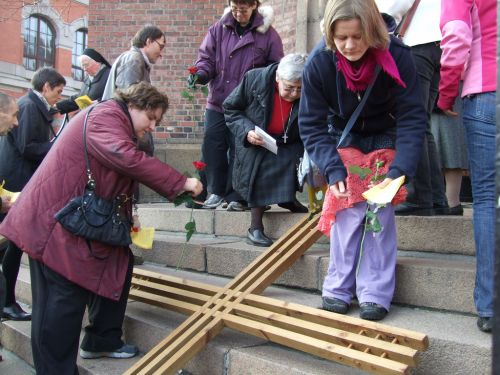 Korsvandring in Oslo, Norway
Korsvandring in Oslo, Norway
On Moundy Thursday or Easter Eve Swedish children traditionally dress themselves as witches and wizards. They go from house to house throughout their neighbourhood. They give a decorated “Easter letter” in hope that they are going to get some sweets or few coins. This tradition is especially popular in the west of the country. There it is also customary to deliver the letter without being seen.
On Good Friday boys from the north of Sweden used to visit local farms carrying birch twigs. There they whipped girls until they gave them something to drink. Everything did not pass without revenge. In the night between Easter Sunday and Easter Monday it was girl's turn to whip the boys.
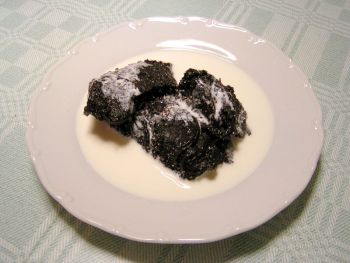 Mämmi
Mämmi
No Easter in Finland is the same without mämmi. This sweet dish is consumed by Finns for centuries. Its main ingredients are water, rye flower, rye malt (as powder), dark molasses, salt and powdered Seville orange peel. Despite being available in Finnish shops all year round, some say that its popularity during lent is partly due to its potential laxative characteristics.
Churches do not use their bells from Great Friday until Easter Sunday. In the meantime people in Ukraine replace them with sound of wooden clappers or by striking of a mallet on a wooden board.
A special bread called Paska (in plural Pasky) is prepared for the Easter meal in Ukraine. Its preparation should be done before the Good Friday (Strasna P’yatnytsya — Passion Friday). Paska was once traditionally prepared in firewood oven. A willow twig blessed on Palm Sunday was also thrown in the fire. During making of the bread people did not swear or talk loudly. The person preparing it was dressed in clean clothes. A blessing for the successful baking was asked.
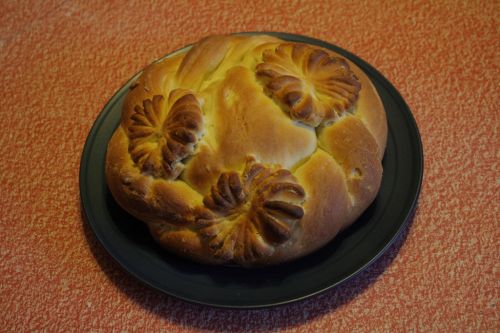 Paska
Paska
A wooden tool used for taking the bread out of the oven had an extra purpose. People used it to bless the oven, doors and windows. They repeated the following words - “Sacred bread — into the house, the evil — out!” The appearance of finished Paska was also important. Nice Paska meant good luck for the family in the coming year.
In Poland people have various Easter traditions like for example Baranek Wielkanocny and Dyngus (Smigus-dyngus, „Lany Poniedziałek“). Very important dish consumed on Easter Sunday is soup called żurek or żur. This soup is made of soured rye flour and some meat (pork sausages, ham or bacon). Rye flour can be replaced with wheat one. Such a soup is then known as barszcz biały ("white barszcz").
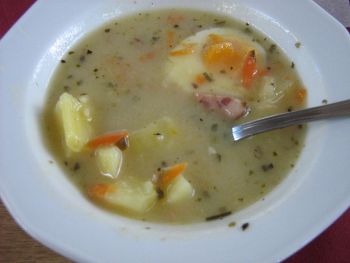 Żurek or żur
Żurek or żur
In Lithuania Velykos Kiškis (Easter Bunny) bakes bunny-shaped biscuits in the early hours of Easter Sunday. He later brings them to good children.
Lithuanian parents with little kids do not worry if it rains on Easter Sunday. According to a local belief people bring kids out as pouring rain will make them grow fast.
Do not be surprised if you see that after the Easter Mass people walk fast or even run towards their home. Lithuanians believe that the person who arrives first will be successful during whole year.
In Germany there is a tradition of the “Easter fire”. People make a huge bonfire by burning old Christmas trees. This bonfire is a way to welcome the Spring.
The Czechs have something what they call the Easter “pomlázka” ( derived from pomladit or "to make younger"). People make whips by braiding several pussywillow twig into a whip. It is believed that being whipped brings good health and youth. On Easter Monday boys whip girls on their legs. In the past pomlázka also included whipping of all farm animals, farmer and children by the farmer's wife.
In the northern Moravia region of the Czech Republic pupils end their school on Ugly Wednesday (“Škaredá středa”). On Green Thursday (“Zelený čtvrtek”), Good Friday (Velký pátek) and White Saturday (Bílá sobota) village boys use wooden rattles to make noise when walking through the village. They do it to scare away Judas. Their walk on the last of three days differs as then they make noise in front of each house till they get some money.
Slovaks have a belief that girl should wash herself in a running stream before the dawn of Maundy Thursday. That is way she is going to have beautiful skin and hair. Rinsing your mouth on the same day with the stream water helps in preventing of toothache.
In parts of Slovakia people believe that on Good Friday witches and other evil powers can harm people but also their animals and farms. That is why people eat garlic and even give it to cattle. On Easter Saturday it was traditional to burn everything old and was potentially harmful. This was called “burning of Judas”.
Greek island of Corfu has an unique Easter tradition. The pot throwing starts on Easter Saturday at exactly 11.00 am. This is done to mark the First Resurrection.
On Easter Sunday people in Georgia visit graves of their dead family members.There they have a special meal. People make a toast wishing all the best to the deceased in his or her afterlife.
A glass of wine is poured on the grave or it is left on the grave together with some food. Usually it is a piece of cake and an Easter egg.
Sorrento (in Neapolitan dialect - Surriento) is a town in the province of Campania located in the south of Italy. It is famous for its processions held on Maundy Thursday and Good Friday. The tradition dates from 1500s.
So called white procession is organized in the night between Maundy Thursday and Good Friday by the Santa Monica Main Confraternity. The procession is called the white one as people involved wear white clothes with hoods. It is also known as "dell'Addolorata". The main motive of this procession is Virgin Mary searching for her son, Jesus Christ, who is captured and sentenced to death.
In the evening of Good Friday the same confraternity starts another procession – black procession or the procession of the Dead Christ (“il Cristo morto”). In this procession participants, wearing black clothes, lament on the moment when Virgin Mary found her son, crucified. They walk in front of the statue of Virgin Mary. They carry the simulacrum of Jesus Christ. The town is in absolute silence, all the lights are turned off. Only torches in the procession shine in the night. Suddenly the silence is broken by the choir of 200 singers performing Miserere.
The Italians just love their Easter Monday or “Pasquetta”. It is a day for the picnic. Some people think that the tradition is sort of remembrance on the event when the disciples at Emmaus saw a resurrected Christ. Pasquetta is a day that is spent with friends, what differs it from Easter Sunday or Christmas which are spent with the family.
Lot of delicious food is prepared. Apart from the barbecued meat Italians love to prepare different “frittatas”. Firttata is an egg-based dish similar to omelette. In the south of country people also enjoy a small savory cake called tortaniello. This cake is made of lard, pork scratching, eggs, cheese and pepper.
On Palm Sunday in Portugal a godchild gives his/her godparents an olive branch, flowers or some sweets (chocolate or almonds). These objects are then blessed by the priest. They are brought home and kept there during Easter.
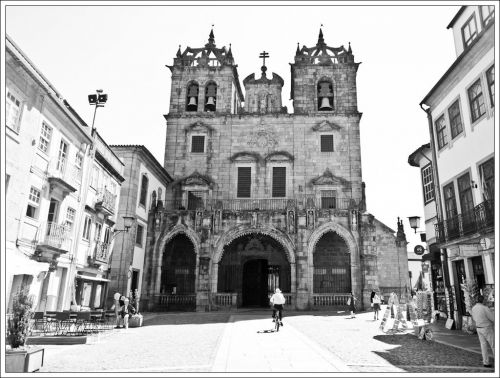 Braga Cathedral (photo by Jos Dielis)
Braga Cathedral (photo by Jos Dielis)
Braga is the Portuguese city located in the north of the country. On Maundy Thursday there is the Mass of the Lord’s Supper (Missa da Ceia do Senhor) in the famous Braga Cathedral (Sé de Braga). Before this mass the archbishop washes feet of the twelve persons which symbolize the twelve apostles.
On Good Friday people do not eat meat. Instead people eat the cod or some other fish. Like in other Catholic countries there is a big procession called the Procissão do Senhor Morto (Procession of the Dead Lord). On the evening of Holy Saturday there is a mass honoring the resurrection of Christ.
There is an old tradition held on Easter Sunday. Nowadays it exist only in some smaller communities. A priest goes from house to house carrying a figure of Jesus Christ. In every house people kiss the figure. Then they get a traditional Easter bread known as the "folar". It is interesting to mention that before putting the dough into the oven four unpeeled hardboiled eggs are placed on it. Cross-shaped stripe made of dough is then put upon them.
The same as in Italy some Portuguese spend their Easter Monday having a picnic. In the region of Alentejo located in the south-central part of Portugal people then eat lamb. The roast lamb is the most popular Portuguese Easter dish.
Many English people on Easter Sunday observe the performance of Morris Dance. While dancing group of male dancers try to scare away the evil sprit of winter. Music accompanying dancers is usually performed by melodeon. Pipe and tabor, fiddle or accordion are also sometimes used. Depending to the region of origin there are several styles of the dance - Cotswold morris, North West morris, Border Morris, Long sword dancing, Rapper or short sword dancing and Molly dancing. Nowadays Morris Dance is also performed in few other countries like the U.S.A., Australia, Canada, the Netherlands etc.
In Ireland some people do not work with tools on Good Friday. It is done to avoid any wound that would create blood spilling. It is believed that person who died on this day will go directly to heaven. People believe that it is good to cut hair on Good Friday. It should prevent headache.
According to Irish holy water that is blessed on Holy Saturday can ensure good health. Only 3 sips will do. Some holy water is sprinkled on family members. There are farmers who sprinkle little bit of it on their cattle too. Irish Easter Sunday among other things includes removing a small peace of meat pinned on a house wall (in Gaelic “spoilin meith na hlnide”). It has been there during Lent. When removed the meat is burned.
In Ethiopia Easter is known as Fassika. On Easter people come to church dressed in white clothes called yabesha libs. The same as on many other important holidays Ethiopians prepare Dabo. This special bread is cut in the morning of Easter Sunday. After a prayer it is cut by a local priest or the male member of the household.
Mexicans celebrate their Holy Saturday (“Sábado Santo”) or “Sábado de Gloria” by performing several traditions like for example burning of Judas in effigy or the throwing of water at people passing by. Everything turns into a big party. One of the biggest is held in city of Cuidad Juárez (Juárez) located in in the Mexican state of Chihuahua.
The Holy week in Brazil starts with the blessing of palm branches on Palm Sunday. These branches are later used in making of different objects like crosses or banners. Processions with the statues of Virgin Mary and body of Christ are held in almost every town. Streets are then often decorated with beautiful drawings.
Famous Brazilian dish associated with Easter is Paçoca. Paçoca is a traditional sweet made of peanuts and sugar. Brazilian town of Fazenda Nova, Pernambuco is famous for its play about the Passion of Christ (Paixão de Cristo). The play has been organized since 1951 at site popularly known as Nova Jerusalém. Almost 600 people (some 50 are actors) participate in the play. About 10,000 people watch it every year.